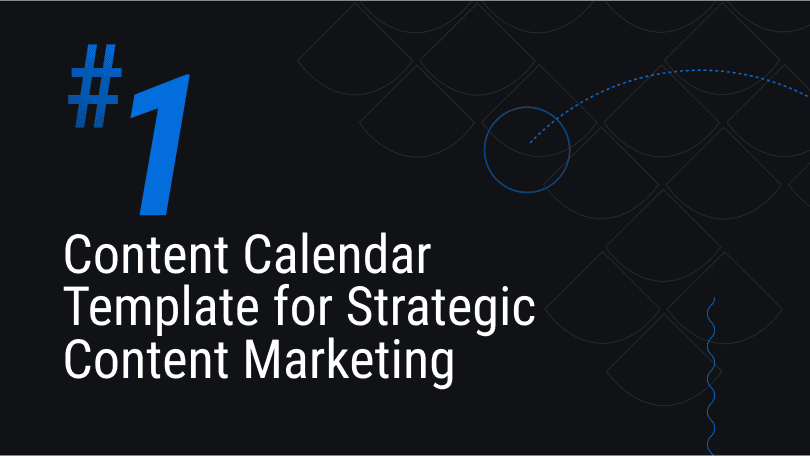Content pillars form the backbone of a well-organized and strategic content marketing strategy for website and social media content. They help ensure your content aligns with brand goals and engages your target audience. Using a content pillar template — like the free template we’ve provided in this article — simplifies organizing and planning your content, making it easier to maintain a cohesive and focused approach across all your marketing efforts.
Fill out the form below and get immediate access to our content pillar template.
What is a Content Pillar?
A content pillar is a central theme or topic that serves as the foundation for a content marketing strategy. Content pillars support various types of content, such as blogs, videos, and social media posts, all designed to address the needs and interests of your target audience.
Creating high-quality, in-depth content pillars achieves multiple benefits, including improved SEO, streamlined content creation, and enhanced brand authority. When defining your content pillars, letting your business goals be the ultimate guide ensures that every piece contributes to building a strong, authoritative brand presence.
Benefits of Having Social Media Content Pillars
Implementing content pillars for social media marketing enhances engagement by promoting consistency and relevance across diverse platforms such as LinkedIn, TikTok, and Instagram. These pillars serve as a strategic framework for content organization, ensuring alignment between social media content and overarching brand objectives and messaging.
Content pillars also facilitate efficient planning and scheduling of varied content types, including social media posts, infographics, and videos. This structured approach streamlines collaboration with content creators and influencers, enabling the maintenance of a coherent and impactful social media strategy. By leveraging these pillars across various channels, marketers can integrate social media efforts with broader marketing goals and ensure consistent messaging across all platforms.
Benefits of Having Website Content Pillars
Content pillars are fundamental for developing an effective website content strategy framework to guide the creation of high-quality, SEO-optimized content across various formats, including blog posts, landing pages, and other web assets. This strategic approach enhances search engine visibility and drives organic traffic growth.
Creating comprehensive and in-depth content pillars offers key long-term advantages, such as higher-quality content, better content organization, and enhanced digital marketing efforts. Using pillars to build a framework for your own content will help you strengthen your online presence and build your brand authority in your industry.
How Does Pillar Content Impact Your Marketing Plan?
Pillar content is crucial in shaping an effective digital marketing plan. Well-structured content pillars provide a strong foundation for your overall content marketing strategy. They have a key influence on various aspects of marketing, from content creation to audience engagement and content repurposing across blog posts, social media marketing, email newsletters, and discussion forums. By aligning your content pillars with business goals, you can enhance brand authority, streamline your content and social media strategy optimization for better metrics, and drive consistent results across diverse channels.
Content Marketing Strategy Impacts
Content pillars have a major impact on your content marketing strategy. Used properly, they organize, guide, and streamline the content creation process, ensuring your content roadmap aligns with your business goals and resonates with the right target audience.
Content pillars influence content marketing strategy by:
- Organizing Content Creation: By providing a clear roadmap for content ideas, content pillars enable businesses to create consistent and cohesive content across all channels, enhancing brand messaging and audience engagement.
- Enhancing Audience Targeting: Through the strategic use of content pillars, businesses can better align their content with the specific needs and interests of their target audience, resulting in improved engagement and more effective communication.
- Supporting Business Objectives: By structuring content around key themes, content pillars ensure that a brand’s content strategy directly supports overall business goals, leading to measurable success and improved ROI on content marketing efforts.
Social Media Strategy Impacts
Content pillars significantly influence social media strategies, providing structure and consistency that can enhance social media marketing efforts, brand awareness, and overall engagement.
Content pillars influence social media strategy by:
- Boosting Brand Relevance and Authority: By creating high-quality, in-depth content focused on key themes, content pillars help establish a recognizable and authoritative brand presence online.
- Enhancing Engagement: By focusing on well-defined themes that resonate with the target audience, content pillars help keep social media content relevant and compelling, fostering increased user interaction.
- Optimizing Performance Metrics: The structured approach of content pillars facilitates more effective tracking and analysis of social media performance, enabling continuous optimization of content strategy.
Content Planning: How to Create Pillar Content
Below, our step-by-step guide breaks down the process of creating pillar content to streamline your content planning and creation efforts. We’ll emphasize using a content calendar template to maintain a steady workflow and plan your content production accordingly. Whether you’re brainstorming pillar ideas or ready to establish a social media content calendar, this approach will help you scale your content creation process efficiently.
Define Content Pillars
Identifying and defining content pillars involves selecting central themes relevant to your brand and aligned with your business goals. These pillars should guide the creation of high-quality, in-depth content that resonates with your audience. To choose effective content pillars, consider what topics are most important to your audience and how they intersect with your business objectives.
For example, a well-known fitness brand might establish content pillars around “Healthy Living,” “Exercise Routines,” and “Nutritional Advice.” Each pillar would include various subtopics, such as meal planning under “Nutritional Advice” or beginner workouts under “Exercise Routines,” ensuring comprehensive subject matter coverage.
Identify Subtopics for Each Pillar
A comprehensive brainstorming session is crucial when developing subtopics for each content pillar. This process involves employing divergent thinking to generate a diverse array of content ideas that thoroughly encompass your selected pillar.
Here’s how to approach this step effectively:
- Mind Mapping: Start with your main pillar topic at the center and branch out with related subtopics. This visual technique helps you see connections and generate new ideas.
- Keyword Research: Utilize SEO tools to identify popular search terms related to your pillar. This ensures your subtopics align with what your audience is actively seeking.
- Competitor Analysis: Examine what topics your competitors are covering within similar content pillars. This can reveal gaps in your own strategy and inspire new ideas.
- Customer Feedback: Review customer questions, comments, and pain points to identify relevant subtopics that directly address their needs and interests.
- Industry Trends: Stay updated on current trends and emerging topics in your field to ensure your content remains relevant and forward-thinking.
By employing these strategies, you can create a multifaceted approach that ensures holistic coverage of the subject matter, addressing various aspects of the central theme. By doing so, you provide your audience with nuanced, valuable information that demonstrates your expertise and authority in the field.
Draft a Pillar Content Outline
Creating a comprehensive outline for an ultimate guide involves developing an overarching structure that includes an introduction, main sections, and a conclusion. Each main section should have subsections corresponding to the subtopics identified in the previous step, and your conclusion should recap key points, provide final thoughts, and include a call to action.
To optimize the guide’s effectiveness, implement a robust interlinking strategy. Ensure each subtopic section links back to the main guide, while the guide itself incorporates links to these subtopic sections. This strategy enhances user navigation and bolsters SEO performance by creating a cohesive, comprehensive resource for readers to explore in depth and for search engines to index.
Plan Interlinking and Content Distribution Strategies
When planning your interlinking strategy, map out how pillar content should link to related subtopics and other mid to bottom-funnel content on your website. This interlinking enhances SEO performance and provides a better user experience by guiding readers through relevant content. Effective interlinking strategies include incorporating internal links within blog posts, landing pages, and pillar pages, ensuring that each piece of content is part of a cohesive whole.
In addition to interlinking, consider strategies for repurposing pillar content across various channels. Content from pillar pieces can be adapted into different formats, such as social media posts, email campaigns, webinars, whitepapers, and discussion forums. Repurposing and distributing content helps maximize its reach and impact while maintaining consistency and reducing content creation time. When planning social media posts and campaigns, use content from your pillars to reinforce key messages and maintain a unified brand presence across all platforms.
Update Website & Social Media Content Calendars
Creating a content calendar is essential for ensuring a steady flow of social media posts and website updates. Identify key themes and topics for your website content, then break these down into specific blog posts, articles, and updates, scheduling them on a monthly or weekly basis.
Leverage tools like Excel, Google Docs, and content planning apps to build your content calendar template. These tools help streamline your workflow by providing a visual representation of your content schedule, making it easier to manage deadlines and coordinate efforts across your team.
Using a social media content calendar allows you to align your posts with key dates and campaigns, ensuring that your messaging is consistent and timely. Whether you’re planning a series of social media posts or a blog awareness campaign, a well-structured content calendar keeps your content strategy on track and aligned with your goals.
Download Our Content Pillar Template for Free, Now!
Content pillars are the cornerstone of an effective content strategy, driving the creation of authoritative, SEO-optimized content across multiple formats. By leveraging our comprehensive content pillar template, you can ensure your content aligns seamlessly with your strategic objectives, resonates with your target audience, and propels your brand to the forefront of your industry.
Our template is designed to streamline your content planning process, enabling you to:
- Develop a cohesive content ecosystem that reinforces your brand’s authority
- Optimize your content for search engines while maintaining a focus on user value
- Facilitate efficient content repurposing across various channels, maximizing ROI
- Enhance your content distribution strategy through strategic interlinking
By downloading our free content pillar template, you’re equipping your team with a powerful tool to elevate your content strategy. Take the first step towards transforming your content planning approach and driving measurable results.
Fill out the form below and get immediate access to our content pillar template.




